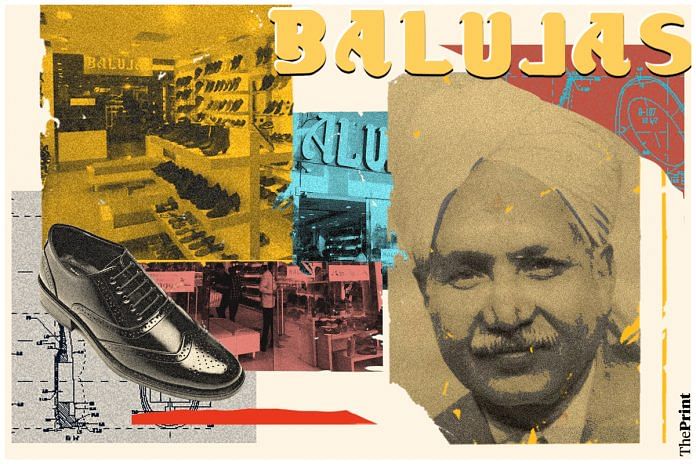Truth or Dare’ is not just an interesting game for adolescents. Real life situations that imitate this game can sometimes have a deep resonance on entrepreneurship – as it happened in the case of Lala Amar Nath Baluja and the birth of Balujas Shoes, one of the most iconic shoe brands of India.
Sometime around 1915, Lala Ishwar Dass Baluja, a patwari (land record officer) from Akalgarh in present-day Pakistan was transferred to Delhi. His eldest son Jagan Nath started a lime producing or chuna-bhatti unit in Paharganj.
Soon his second son Amar Nath joined them. The 6’2″ boy was roaming the streets of Chandni Chowk to buy a pair of shoes but none would fit him. Exasperated, he asked a shopkeeper why they don’t make better fitting shoes. The shopkeeper challenged him to make better shoes himself, arguing that no Hindu would enter the leather business.
Amar Nath, feeling rebuked, took the ‘dare’ to heart and told him he will be the first to break the taboo.
“The shopkeeper laughed and commented that these are just empty boasts. This skirmish was the start of the Baluja empire by my grandfather,” says Rohit Baluja, one of the owners.
Also read: Bina Musicals’ harmoniums haven’t lost the tune. It started with British order and a blessing
A business is born
Fired up by the verbal duel, Amar Nath started working to find suppliers and vendors to create a supply chain for his business. He opened a footwear store called ‘Baluja Boot House’ in Chandni Chowk in 1919. His elder brother Jagan Nath and three younger brothers Chuni Lal, Brijlal, and Kundan Lal supported his endeavour.
The business was barely four years old when the shop was destroyed in a fire. But in business, sometimes a challenge becomes an opportunity. Amar Nath found a bigger shop in Fatehpuri in Chandni Chowk. Instead of getting daunted by the fire accident, he grabbed the opportunity and opened an even bigger showroom. He opened yet another showroom next to Town Hall in Chandni Chowk in 1926. Now all five brothers were pulled into the business.
The business model was mainly dependent on procuring fine quality raw materials and entrusting accomplished kaarigars in various karkhanas (factories) to make good quality shoes out of them. “To ensure better raw stock and find new pools of talent at various traditional shoe making hubs – one brother Chuni Lal was sent to Agra and another cousin Dina Nath was sent to Kanpur,” said Rohit Baluja.
Chuni Lal made great strides in ensuring standardisation of size, shape, cut, and colours of the shoes. Great attention began to be paid to heels, thread and laces. This was the first attempt in standardisation by any shoe brand in India and the result began to be visible with each Balujas pair coming out from the factory.
Another cousin Dina Nath, in Kanpur, took advantage of the local skill in making slippers or open-style Indian footwear. He developed the Kanpuri chappals and sandals which became a brand in their own right. These chappals began to be sold across north India – from Bihar in the east to Karachi and Sialkot in the west.
Amar Nath’s youngest brother Kundan Lal decided to woo the well-off customers with better design and opened a plush showroom in the newly launched Connaught Place in the heart of Delhi.
Meanwhile, Amar Nath continued his relentless pursuit of branding and growth by opening another outlet in Karol Bagh, which proved to be extremely popular with the middle class.
Also read: Viceroys to Rekha to Yash Chopra—Ushnak Mal silk saris a hot favourite for over 100 yrs
Firmly established
With the new laws of patents and trademarks coming to India – the Balujas name was formally registered in 1944. By now, the Baluja brand had become popular and was easily recognised in most homes. It became the choice of footwear for public figures like Jawaharlal Nehru, Rajendra Prasad and others. In archival photographs, these personalities can be seen wearing the Baluja Peshawari chappals, the Cross sandals, the Baluja formal Oxford shoes and other designs of the 1950s and ’60s.
“A big shift happened in 1977 when I opened my own manufacturing units. For the first time, the master craftsmen took a back seat and the factory supervisors took over. Our design team and factory supervisors made the non-specialised artisans re-create set designs. Following this, we began exporting our shoes and shoe uppers to foreign markets. In 1995, I established a shoe plant with machines from Germany, the UK, and Italy. By now, our Baluja shoes were being exported to many regions including Europe, Middle East, and Russia,” says Rohit Baluja.
Brands are almost like people. They rise and then see their twilight years. Each brand is born in unique circumstances, it has a distinct personality and life arc. Like people, brands are shaped by events and reach their crest if they find muster and enthusiasm of their founders. But pulls and pressures of territorial battles over ownership can shrivel the brand. Balujas too may not be the alpha brand it once used to be – but it’s still a loved brand that is sold in almost 100 outlets across India. And it still evokes nostalgia.
This article is a part of a series called BusinessHistories exploring iconic businesses in India that have endured tough times and changing markets. Read all articles here.



